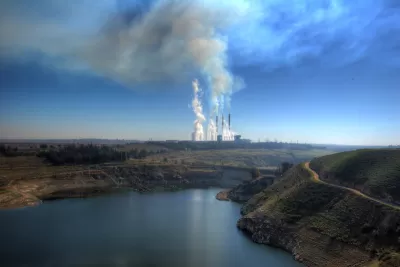Long considered unfeasible, direct-air capture of carbon dioxide has been achieved by a set of entrepreneurs. Scaled up, the expensive technology could slow climate change.

Akshat Rathi reports on a group of companies making significant strides on direct-air capture of CO2. Essentially, the process "consists of machines that work like a tree does, sucking carbon dioxide (CO2) out from the air, but on steroids—capturing thousands of times more carbon in the same amount of time."
Direct-air capture has been written off as financially unfeasible. "For the past decade, a group of entrepreneurs—partly funded by billionaires like Bill Gates of Microsoft, Edgar Bronfman Jr. of Warner Music, and the late Gary Comer of Land's End—have been working to prove those estimates wrong."
In a major step forward, "On Oct. 11, at a geothermal power plant in Iceland, [Switzerland's Climeworks] inaugurated the first system that does direct air capture and verifiably achieves negative carbon emissions." The machine is still at pilot scale, but it's also "the first system to convert the emissions into stone, thus ensuring they don't escape back into the atmosphere for the next millions of years."
Deployed at a far greater scale, direct-air capture could be an effective "insurance policy" against climate change. It would involve "spending $500 billion each year capturing carbon dioxide from the air. It seems outrageous, but it may not be if climate change's other damages are put in perspective—and that's what these startups are betting on."
FULL STORY: The world’s first “negative emissions” plant has begun operation—turning carbon dioxide into stone

Alabama: Trump Terminates Settlements for Black Communities Harmed By Raw Sewage
Trump deemed the landmark civil rights agreement “illegal DEI and environmental justice policy.”

Study: Maui’s Plan to Convert Vacation Rentals to Long-Term Housing Could Cause Nearly $1 Billion Economic Loss
The plan would reduce visitor accommodation by 25% resulting in 1,900 jobs lost.

Why Should We Subsidize Public Transportation?
Many public transit agencies face financial stress due to rising costs, declining fare revenue, and declining subsidies. Transit advocates must provide a strong business case for increasing public transit funding.

Paris Bike Boom Leads to Steep Drop in Air Pollution
The French city’s air quality has improved dramatically in the past 20 years, coinciding with a growth in cycling.

Why Housing Costs More to Build in California Than in Texas
Hard costs like labor and materials combined with ‘soft’ costs such as permitting make building in the San Francisco Bay Area almost three times as costly as in Texas cities.

San Diego County Sees a Rise in Urban Coyotes
San Diego County experiences a rise in urban coyotes, as sightings become prevalent throughout its urban neighbourhoods and surrounding areas.
Urban Design for Planners 1: Software Tools
This six-course series explores essential urban design concepts using open source software and equips planners with the tools they need to participate fully in the urban design process.
Planning for Universal Design
Learn the tools for implementing Universal Design in planning regulations.
Smith Gee Studio
Alamo Area Metropolitan Planning Organization
City of Santa Clarita
Institute for Housing and Urban Development Studies (IHS)
City of Grandview
Harvard GSD Executive Education
Toledo-Lucas County Plan Commissions
Salt Lake City
NYU Wagner Graduate School of Public Service





























